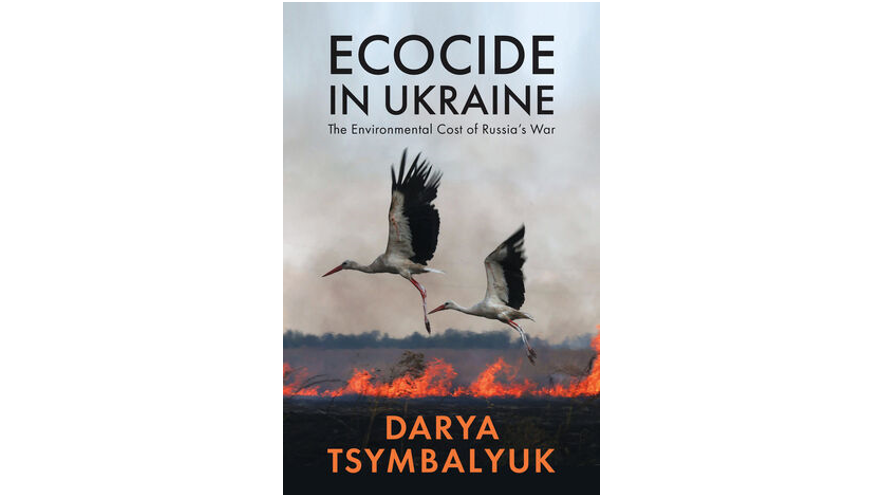The Environmental Cost of Russia’s War
Darya Tsymbalyuk
Polity, 2025, 188 pages
Paperback £14.99 | ISBN 978-1-509-56250-3
Review by Janet Mackinnon
This book offers an urgent reminder of the profound impact of modern technological warfare on the natural and built environments. In the three and a half years since the outbreak of the most significant European conflict since World War 2, public attention in countries not directly affected has inevitably reduced. Meanwhile, as US President Trump has discovered, there is limited prospect of a substantive and just peace ‘deal’ with Russia. A basic reason for this is the potent (and toxic) geo-political ideology of Russian World. Espoused by the country’s political and military elites, it is used to mobilise popular support for the wars on Ukraine which began in 2014 with the annexation of Crimea and invasion of the eastern Donbas region. Anyone in doubt as to the regime’s deeper motivations should read some of the genocidal propaganda from intellectuals linked to influential platforms like the Valdai Club, including the belligerent rhetoric1 of those promoting nuclear conflict with Europe and the UK whilst pivoting Russia’s centre of gravity east towards Siberia.
It is one of recent history’s tragic ironies that largely unpropitious late 20th and early 21st century efforts to enshrine the crime of ecocide within international law have been granted considerable impetus in Europe and beyond by the environmental consequences of Russia’s full-scale invasion of Ukraine.2 As Darya Tsymbalyuk notes in the preface to her book: “On the domestic level, Ukraine is one of little more than a dozen countries in the world that have an article for ecocide in their criminal code (Article 441)”. However, in 2023 the European Parliament obtained inclusion of severe environmental harms ‘comparable to ecocide’ in the EU’s revised environmental crime directive, and an Ecocide Bill is currently under consideration by the Scottish Parliament.3/4 Much of the global public campaign to make ecocide a crime fully recognised in national and transnational legal systems has been led by the UK-based Stop Ecocide International.5 As Tsymbalyuk’s preface again points out, in 2021 this group’s independent expert panel defined ecocide “as unlawful or wanton acts committed with knowledge that there is a substantial likelihood of severe and either widespread or long-term damage to the environment being caused by those acts.”
Alongside its review of Ecocide in Ukraine – The Environmental Cost of Russia’s War, the following discussion will consider how campaigns to tackle ecocide have gained considerable momentum in recent years. It will also describe how Ukrainian nature conservation groups working on the ground continue to document, adapt to and mobilise against widespread and long-term damage to internationally significant land-based, fresh water and marine ecosystems. Unfortunately, Russia’s full-scale invasion of Ukraine remains very much an ongoing situation that has fundamentally challenged norms of international law and the so-called rules-based world order, as indeed does the continuing more localised annihilation of Gaza6 by Israel. In this extremely challenging context, Tsymbalyuk’s book does not offer legal scholarship but contemporary and historical Ukrainian accounts of “how experiences of witnessing and living through ecocide changes one’s understandings of environments and one’s home(land).”
With a doctorate from St Andrews in Scotland, Tsymbalyuk is currently based in the United States, where she is an Assistant Professor in the Department of Slavik Languages and Literatures at the University of Chicago. Ecocide in Ukraine was researched and written between 2023-4 when the author returned to the southern region of the country where she has “lived half her life” and which provides the spatial focus of her narrative. This region was also profiled in a 2022 ECOS feature that formed part of a series of articles entitled Conflict, Post-Colonialism and Conservation.7 (Post-)colonialism and coloniality (enduring power structures linked to the former and strongly evident in the natural resources sector) are described by Tsymbalyuk as a complex and deeply problematic legacy of Ukrainian and Crimean rule by Imperial Russia and the Soviet Union. The history of the Kakhovka Dam on the River Dnipro (Dnieper), from its construction during the 1950s as part of the Stalinist ‘Great Plan for the Transformation of Nature’ to its destruction by Russian forces in 2023, reflects brutal modifications of freshwater environments with disastrous consequence for wildlife and people. Destruction of the dam is widely cited as a classic case of ecocide, although again it is not without irony that riverine ecosystems – known collectively as the Great Meadow (Velykyi Luh) – originally destroyed by it have now started to recover through natural processes of rewilding.8
A meeting focused on Ukraine organised last year by the International Union for the Conservation of Nature (IUCN) Regional Forum for Europe, North and Central Assia prioritised three central themes for consideration: the need to assess “the true extent of environmental damage caused by the war; spontaneous ecosystem recovery in areas where economic activity has been forced to cease”; and “the importance and possibilities of prioritizing nature conservation as a cornerstone of post-war reconstruction efforts”.9 Tsymbalyuk’s book concentrates on the first two themes with particular reference to her home city of Mykolaiv and the strategically important region of Dnipropetrovsk Oblast spanning central, southern and eastern areas of the country; although a broader if not fully comprehensive picture emerges. It is noteworthy that ECOS contributor Hannah Timmins led a 2023 study in conjunction with Ukrainian nature conservationists which examined the nation-wide condition of protected areas following Russia’s full-scale invasion.10 Similarly, the UK-based Conflict and Environment Observatory has monitored the impact of war in Ukraine since 2014. Whilst Tsymbalyuk’s account reflects the ongoing technical assessment of environmental damage as well as spontaneous ecosystem recovery, its strength lies in bringing a humanities – and more-than-human – perspective to a combination of scientific observations and extensive war reportage.
There is an excellent review of Ecocide in Ukraine by the geographer Dr Alexander Vorbrugg on the regularly updated and highly informative Ukraine War Environmental Consequences Work Group (UWECWG) website.11 Tsymbalyuk’s own site also provides background information about her book, academic and broader work.12 These “explore narratives about environments, multispecies worlds, displacement, embodied knowledge, and entangled colonial histories of Ukraine.” The book is among the best examples of environmental humanities writing as it eschews much of the theoretical jargon often associated with Anglophone offerings in this category and remains grounded in the spatial environment at all times. Like the previously reviewed Outrage, Tsymbalyuk’s narrative is also to be congratulated for its admirable brevity containing more insights and impact than many longer volumes. After a short preface which explores the meaning of ecocide, chapters discuss the effects of war on Ukrainian river and marine ecosystems, land and soil, air, plants, bodies (animal and human) and energy resources in both the present and historical contexts.
As a scholar of culture and languages, the author is particularly interested in words and their meaning. This is exemplified in her use of ‘Zemlia’ (‘land, soil, earth, ground’) for the title of the second chapter. Along with its important secular connotations, Darya Tsymbalyuk observes the word is also used by many Ukrainian churches to denote “ ‘this earthly world’, the world full of earthly sorrows, in opposition to ‘nebo’, the skies that hold life eternal.” In a war that has taken on explicit religious and wider spiritual dimensions for both Russian aggressors and the defenders of Ukrainian zemlia, the multi-faceted connotations of this term are important to acknowledge. Towards the end of Ecocide in Ukraine, the output of Soviet Ukrainian film maker Oleksandr Dovzhenko is mentioned with reference to the post-humous Poem of the Sea completed by his wife, Yuliya Solntseva, and released in 1958. This film dramatizes the environmental impacts of the Kakhovka Dam and Hydroelectric Power Plant, justifying these as an essential part of the Soviet Union’s industrialisation. However, Dovzhenko is known for a certain ambivalence to modernity, as reflected in the 1930 silent film Zemlia (‘Earth’), generally regarded as his finest production and described by the British Film Institute as an “impassioned hymn to nature.”
The Ukrainian Nature Conservation Group receives several mentions in Tsymbalyuk’s book along with the Center for Environmental Initiatives Ecoaction.13/14 Like UWECWG with whom they collaborate, these groups help ensure that conservation, sustainability and ecosystem restoration issues remain on Ukraine’s broader political agenda. This task is far from straightforward as UNCG chairman and co-founder Oleksii Vasyliuk points out to the author: “On the international level you hear everywhere about ecocide, which is great, but if you look at the local level nothing has changed – entrepreneurs try to extract resources in protected areas, farmers who were displaced from the occupied areas try to find ways to plough protected areas…” More recently, Vasyliuk has written about ‘Ukraine’s green recovery: legislative step toward eco-integration in reconstruction’ in which he outlines some of the central challenges.15 Meanwhile, a post on the European Journal for International Law blog entitled ‘The First Ecocide Treaty?’ discusses the Council of Europe’s adoption of a new ‘Convention on the Protection of the Environment through Criminal Law’ as a significant advance in the field of environmental criminal justice.16 Given that war damage to the environment is now estimated by the Ukrainian government at €108bn, obtaining Russian reparations is likely to prove a key testing ground for international law.17
Although Tsymbalyuk does not seem to use the term Wild Fields, this historical description of the Pontic steppe in present-day Eastern and Southern Ukraine, including Russian-occupied areas, defines a central locus of her narrative. Despite continuing attacks on the country as whole, including major cities and critical infrastructure, this territory has by far borne the brunt of Russia’s annexations and invasions since 2014. By 2022, many commentors had identified control of strategic regions in the so-called Wild Fields as the main object of escalating Russian aggression; with the former British war correspondent, Aris Roussinos, predicting in Unherd that “the fate of Europe lies in the steppes”.18 While Tsymbalyuk comes from a military family, she does not write in detail about front line warfare but its environmental consequences for nature and people. She uses the expression ‘episteme of death’ – embodied knowledge derived from an all pervasive and ever-present sense of mortality and possible extinction – to describe the impact of war on “certain endangered species…on habitats and ecosystems, and on Ukraine’s communities overall.” Another tragic casualty of this existential predicament is restoration work supported by the UK-based Endangered Landscapes and Seascapes Programme (part of the Cambridge Conservation Initiative) focussed on the Azov-Black Sea ecological corridor as described in the 2022 ECOS feature on Ukraine.19
The active combat zone includes Kherson region’s Black Sea Biosphere Reserve, formerly the largest nature reserve in Ukraine, and currently under Russian occupation. The site is listed under the Ramsar Convention and, although Russia has recently withdrawn from this, around the same time its Ministry of Natural Resources assumed control of a newly state-designated ‘Black Sea Nature Biosphere Reserve’. This arrangement is heavily criticised by UWECWG as an example of Russian political manoeuvrings in the absence of a genuine conservation mission.20 Nevertheless, Russia’s ‘special military operation’ has apparently mobilised serious concerns about ‘collateral damage’ to the environment, especially in and around the Black Sea, among its own citizens.21 At the time of writing this review, Presidents Trump and Putin are due to meet in Alaska, and the majority of Ukrainian and Russian citizens favour an end to hostilities but understand this is not going to be a straightforward process. Let us hope that as with the 1986 Chornobyl Disaster, some environmental consequences of Russia’s war on Ukraine turn out to be positive. In the meantime, to quote American poet Emily Dickinson, “‘Hope’ is the thing with feathers” symbolised by the now famous Ukrainian white storks flying over burning fields on the front cover of Darya Tsymbalyuk’s book.22/23
References
1. https://eng.globalaffairs.ru/articles/europe-a-bitter-parting-karaganov/
4. https://commonwealth.sas.ac.uk/news-events/news/world-leading-ecocide-law-introduced-scotland
5. https://www.stopecocide.earth/
6. https://theecologist.org/2025/sep/02/ecocide-and-resistance-palestine
7. https://www.ecos.org.uk/ecos-43-3-1-1-ukraine-transboundary-conflict-and-conservation
11. https://uwecworkgroup.info/ecocide-in-ukraine-the-environmental-cost-of-russias-war-book-review
12. https://daryatsymbalyuk.com/
14. https://en.ecoaction.org.ua/
16. https://www.ejiltalk.org/the-first-ecocide-treaty
18. https://unherd.com/2022/07/the-fate-of-europe-lies-in-the-steppes
19. https://www.endangeredlandscapes.org/project/azov-black-sea-corridor
22. https://www.poetryfoundation.org/poems/42889/hope-is-the-thing-with-feathers-314


